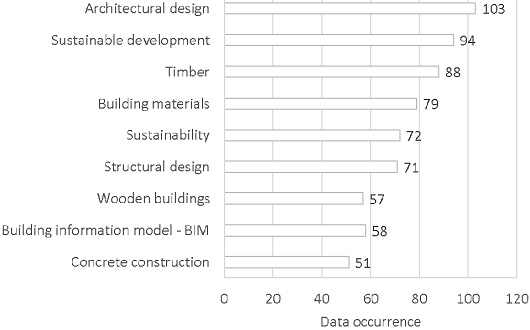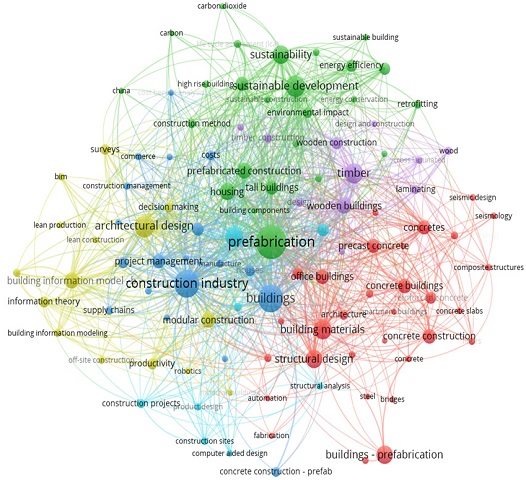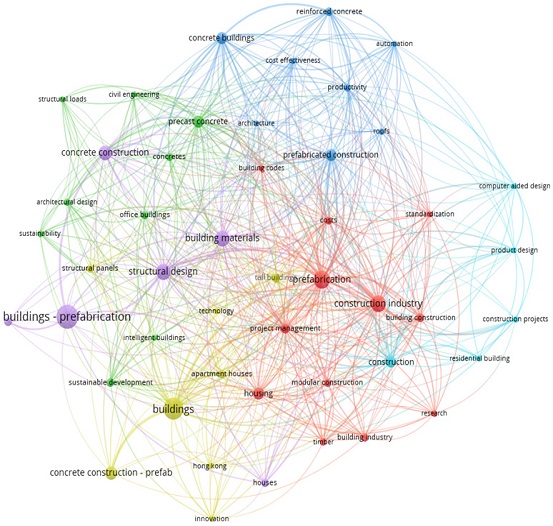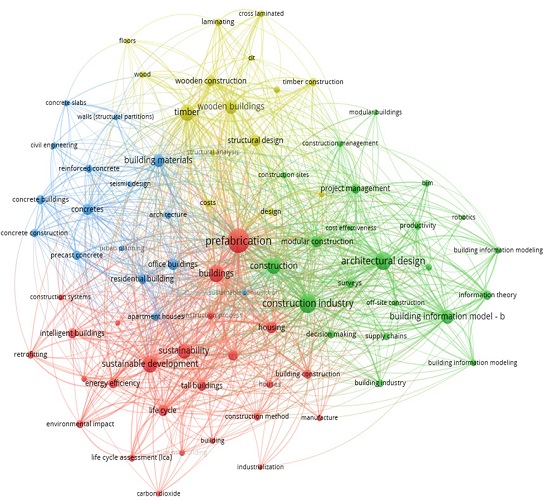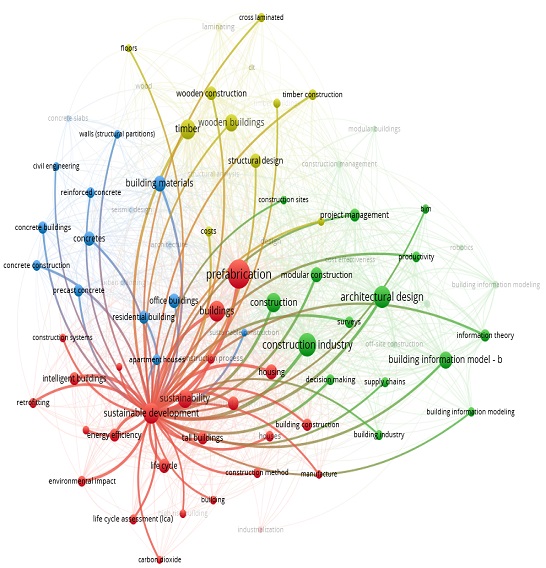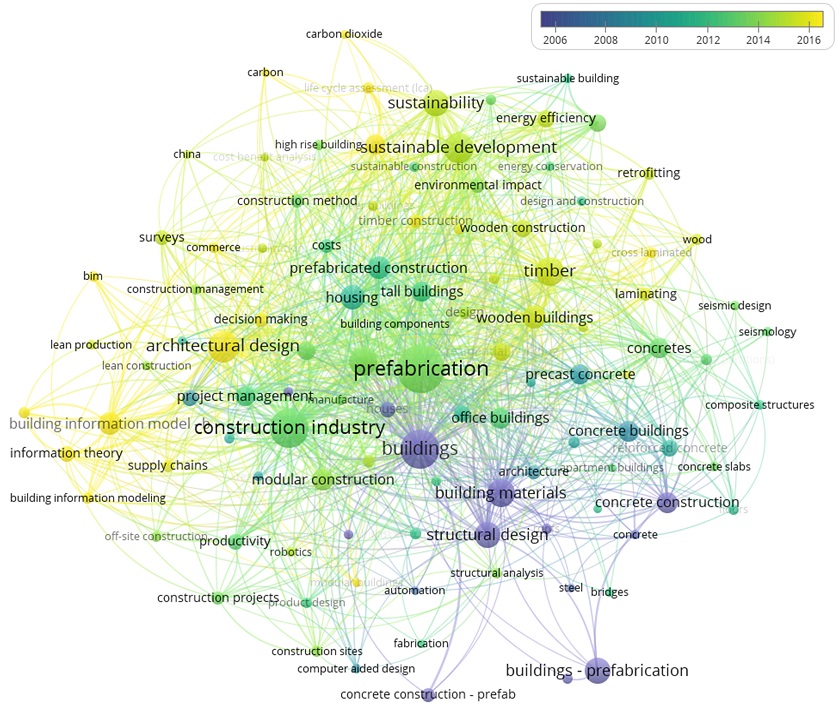
Trend Analysis of Overseas Research for Performance Improvement of Modular Buildings
ⓒ2021. KIEAE all rights reserved.
Abstract
The objectives of this study were to analyze international research on modular architecture through careful review and to derive implications from overseas research for proposing a suitable direction of domestic research for the activation of smart construction technology in the future.
Numerous prior foreign studies were compiled using the software VOSviewer. In the present study, the research on modular architecture conducted overseas through keyword analysis was considered more widely, and the main implications of foreign research were derived through clustering and used as basic data for research on modular architecture in Korea and for future performance improvement. To this end, 589 internationally conducted studies from the SCOPUS search engine were collected, and the data were analyzed using VOS.
The research on modular architecture can be divided into six clusters. Similar to domestic studies, modular architecture research was the most important study of construction and structure as well as architectural design. This has been consistently carried out from the past to date. Additionally, there have been significant changes in the research trend of modular architecture in the past decade, particularly in 1) the modularization of wooden architecture, 2) research in the building information modeling field, and 3) research on sustainable development. Among them, the increase in research in the field of sustainable development was most pronounced.
Keywords:
Modular Building, Thesis Keyword, Derivation of Research Direction, Literature Review1. Introduction
1.1. Research Background and Objectives
The Korean government recently released a plan to foster innovation drivers in an attempt to lead the fourth industrial revolution. In response to this plan, the Ministry of Land, Infrastructure and Transport sought to promote smart construction technology by implementing “The 6th Basic Plan for the Promotion of Construction Technology, 2018-22.” [1] Among the smart construction Smart construction technologies, modular architecture has been proposed as a major alternative.
Modular architecture is a construction method that allows for the construction of large buildings in a relatively short time compared with conventional construction methods. Its many advantages, e.g., mobility, combination, and speed, make it highly favorable with regard to various aspects, including economics, environmental protection, and energy. Owing to these advantages, modular architecture is currently being constructed and studied in military-related accommodations, [2, 3] temporary housing, [4] dormitories, etc.; however, its application to general residential buildings has been limited, as most houses are built in a detached or low-rise configuration. [5, 6]
Numerous foreign studies have been undertaken on modular architecture. Consequently, demonstration buildings have been established for various purposes, including housing, and recently, studies on the performance improvements offered by modular architecture have been actively conducted.
Therefore, the objectives of this study were to analyze overseas research on modular architecture through careful review and, according to the implications drawn from those overseas researches, to propose a suitable direction of domestic research for the invigoration of smart construction technology in the near future.
1.2. Research Method and Scope
To contribute to the revitalization of modular architecture, we suggested a direction for improvement and future research concerning modular architecture in South Korea by examining previous overseas studies.
We considered a substantial number of studies conducted abroad. These previous foreign studies were compiled using VOSviewer (www.vosviewer.com), which is a text mining-based program with the following features: 1) it collects the bibliographic database through synchronization with various search engines; 2) it analyzes the author, the co-occurrence with the target research paper, and the keywords; 3) it derives the correlation of the analyzed data; 4) it clusters the analyzed data; and 5) it visualizes the analyzed data.
VOSviewer is used in various fields for literature review of precedent studies or to investigate research trends.
In this study, research conducted overseas on modular architecture was extensively scrutinized using keyword analysis, and recent changes in research trends were analyzed. According to the results, the major implications of overseas studies were identified through clustering, and their use as the fundamental data for activating research on modular architecture and supporting future research on performance improvement in South Korea is proposed.
2. Scrutiny of Foreign Studies on Modular Architecture
2.1. Status of Modular Architecture Research in Foreign Countries
In this study, bibliographic information from SCOPUS (https://www.scopus.com/), which is operated by Elsevier, was utilized. Using the search engine, 589 precedent studies related to modular architecture were found. The main keywords entered in SCOPUS were “modular,” “architecture,” “building,” and “prefabrication.” However, because the keyword “modular” is commonly used in various fields other than architecture and construction, the keyword-specific data used for this study were collected only after separately limiting the range of data to architecture- and civil engineering-related fields.
Fig. 1. shows the frequency of the analyzed data, indicating the top 10 keywords with the highest frequency within the SCOPUS database. These were the top 10 most frequently used keywords in the previous studies on modular architecture registered in SCOPUS, providing the easiest way to grasp the trends in foreign research.
Among the keywords, general terms such as “building,” “prefabrication,” “modular,” and “construction” were excluded from the ranking. According to the analysis, keywords shared with the previous domestic studies were “architectural design,” “building materials,” “building,” “housing,” and “concrete construction.” These keywords were also subject to study in the areas of materials, structure, planning, and design within the domestic modular architecture research.
Keywords that reflected conditions different from those of South Korea were found as well. Because many studies on modular architecture based on wooden houses have been performed in Northern Europe and the United States, the analysis revealed a high frequency of words such as “timber” and “wooden design.” Meanwhile, the proportion of wooden houses in South Korea is currently significantly smaller than that in foreign countries. Modular houses are predominantly in the forms of detached and low-rise houses, [5, 6] all of which are concrete structures; hence, this construction method has not been applied to wooden buildings in South Korea.
Additionally, the analysis revealed that certain keywords appeared in research fields other than modular architecture in South Korea. These keywords, including “sustainable development,” “sustainability,” and “building information model – BIM,” are linked to active research in South Korea; yet, only a few studies on modular architecture are linked to these keywords.
This is attributed to the fact that modular architecture in South Korea is currently focused on dissemination and demonstration. Few studies have been conducted on performance improvement in this field in South Korea, and substantial research in the field is expected to be pursued only after the demonstration and dissemination are initiated.
The results of the analysis based on the number of citations are presented in Table 1. [7-16] It was revealed that the top 10 highly cited researches (number of citations: 97–250), including concrete construction, building materials, sustainable development, building information model (BIM), structural design, housing, and construction management, have been studied in various fields. The analysis suggested that the highly cited studies related to modular architecture are decisively dissimilar to domestic studies, except for those related to structure. This is because, again, the modular architectural research in South Korea is mainly in the demonstration and dissemination stage. It is believed that by grafting itself onto the relevant fields overseas, modular architecture in South Korea will be able to contribute in the future with regard to performance improvement and environmental aspects.
2.2. Correlation and Clustering of Modular Architectural Research in Foreign Countries
The bibliographic information was visualized using VOSviewer, and correlations between the data were inferred, as illustrated in Fig. 2. and Table 1. The size of the circle in Fig. 2. indicates the frequency of the keyword, and the distance between circles represents the degree of co-occurrence. The colors of the circles distinguish cluster types. VOSviewer performs keyword clustering by automatically analyzing the correlation and co-occurrence between keywords. Six clusters were derived in this study.
The red and green clusters were evidently the largest of the six clusters. This is because the construction and structure (red) cluster accounted for the largest proportion in the study of modular architecture. The main keywords of the red cluster were (in the order of frequency) “structural design” (69), “building materials” (77), “concrete buildings” (46), and “office building” (46). This indicates that overseas research on modular architecture has been most active in the areas of materials and structures, as in South Korea.
The sustainable development (green) cluster accounted for the second-largest proportion. This cluster consisted of (in the order of frequency) “sustainable development” (92), “sustainability” (72), “housing” (62), “tall building” (42), “life cycle” (42), and “energy efficiency” (33). The results revealed that numerous studies have been conducted on energy-efficiency improvement and life-cycle assistance (LCA) with regard to sustainable development in modular architecture. In fact, many studies have been performed in the field of LCA with a focus on the reduction of the embodied energy required for construction and carbon dioxide (CO2) emissions. Additionally, as the distribution of zero energy buildings expands worldwide, numerous studies on energy performance improvement are being conducted in the modular-architecture field.
The project management and concrete (blue) cluster comprised (in the order of frequency) “construction industry” (146), “project management” (43), “houses” (28), “cost” (24), and “concrete construction – prefab” (22).
Finally, the building information and design (yellow) cluster comprised “architectural design” (99), “building information model – BIM” (54), “information theory” (27), and “productivity” (27).
3. Changes in Modular Architecture in Foreign Countries
3.1. Examining Research Trends of Modular Architecture in Foreign Countries (~2009)
A total of 208 studies were found in SCOPUS for modular-architecture studies conducted prior to 2009 (Fig. 3.).
The main research keywords were (in the order of most performed to least performed) “construction industry” (35), “structural design” (33), “building materials” (33), “concrete construction” (27), “housing” (19), “precast concrete” (18), and “reinforced concrete” (10). Modular-architecture studies conducted prior to 2009 were very similar to studies in South Korea. Many of the studies on modular architecture have been directed toward the issues of structure and material within the areas of demonstration and construction. In particular, previous studies were mainly focused on the concrete and structural design. This can be attributed to the fact that structural improvement has been the first priority in the construction of modular architecture.
Although certain studies dealt with topics such as intelligent building and sustainable development, they were insignificant in number.
The use of the building was focused on “housing” (19), which was used in combination with the keywords “apartment houses (9)” and “residential” (5). Additionally, studies involving tall buildings (12) and office buildings (9) were found, but the frequency was relatively low.
3.2. Examining Research Trends of Modular Architecture in Foreign Countries (2010–2020)
The data on modular architecture-related research conducted over the past 10 years were collected and analyzed, as shown in Fig. 4. The analysis of the year-by-year keywords indicated that the keywords used have changed significantly since 2009. Thus, in this study, the research trends were analyzed by examining the periods of pre-2009 and post-2009.
For the post-2009 period, the following keywords appeared, in the order of frequency: “construction industry” (111), “architectural design” (92), “sustainable development” (82), “timber” (77), “sustainability” (66), “building information model – BIM” (54), “building materials” (44), “housing” (43), “life cycle” (39), “office buildings” (37).
The analysis of the clustering and correlation revealed that changes have occurred in the field of study since the pre-2009 data, which was discussed in Section 3.1 (Table 3.).
Similar to the pre-2009 period, studies on building materials and structural design (concrete) have been actively conducted after 2010. However, these subjects exhibited a high co-occurrence with the keywords that were uncommon pre-2009, such as “energy efficiency,” “sustainable development,” “life cycle,” and “cost.”
Research on modular architecture has transformed in the following ways since 2010. First, the wooden buildings (timber) clustering has undergone a change. Few studies on the modularization of wooden structures were conducted before 2009. However, since 2010, there has been a significant increase in the number of studies on wooden construction. The second transformation is related to building information modelling (BIM). Building information models have recently been studied in various fields, e.g., the construction process and architectural design. Finally, the sustainable development (sustainability, energy efficiency) cluster has grown. Over the past decade, the cluster for sustainable development is most conducted in modular construction.
Sustainable development has been the most extensively studied area over the past decade, and its association with other clusters in modular architecture is strong (Fig. 5). The sustainable-development field is closely related to the existing fields of building material (structure), wooden buildings, and architectural design clusters. Additionally, for improving the performance of existing modular architectures, numerous studies related to LCA, CO2 emissions analysis, and energy efficiency have been conducted in the past decade.
Studies on sustainable development in modular architecture are presented in Table 4. As mentioned previously, the net-zero energy policy has been strengthened internationally. Many of the previous studies were administered in consideration of environmental and energy aspects.
While recent reports reveal that plenty of studies on building energy improvement have been conducted for overseas modular buildings, similar research is rarely found in South Korea. In South Korea, as net-zero energy buildings will become mandatory after 2030, the need for research on energy performance improvement for modular buildings is expected to increase in the future.
Depending on the application scope of the construction method, modular architecture can be divided into cases where the modular construction method is applied to some parts of a unit and those where the method is applied to the entire building. An example of the former approach, where parts of a unit are modules, involves the use of modular construction methods for constructing a wall during building retrofit. This technique has the following advantages: first, Construction period can be reduced compared with conventional construction methods; second, the embodied energy and carbon emissions can be reduced during construction; and finally, the building energy can be reduced owing to enhanced thermal performance. [17-19]
An entire modular building complex is an example of building energy improvement pursuant to the net-zero energy building policy that has become mandatory worldwide. Compared with traditional modular architecture (mainly housing), net-zero energy buildings require a significant reduction in building energy consumption. To satisfy this requirement, passive design and active design have been employed in many cases. [20-24]
4. Conclusions
For enhancing the performance of modular architecture, the objective of this study was to propose a future direction of research for the performance improvement of modular architecture in South Korea, on the basis of an analysis of precedent studies conducted abroad. Accordingly, 589 foreign studies found on SCOPUS search engines were collected, and the data were analyzed using VOSviewer.
1) The study of modular architecture can be organized into a total of six clusters (construction and structure, sustainable development, project management and concrete, building information and architectural design, and wooden buildings). Similar to the research trend in South Korea, “construction and structure” and “architectural design” were the leading topics in research on modular architecture. Related studies have been consistently performed from the past to date.
2) There have been major changes in the research trends of modular architecture over the past decade: 1) the modularization of wood-frame construction; 2) the increase in research concerning building information modeling; and 3) the increase in research on sustainable development. Among them, the increase in research on sustainable development was most apparent.
3) Modular construction cases in sustainable development clustering included research related to the reduction of embodied energy and carbon emissions, as well as thermal performance improvement resulting from the mandatory net-zero energy building policy.
The collected foreign studies covered a wide range of research, and the fact that the direction, correlation among data, and clustering identified from these cases can be referred to by future Korean research clearly implies their significance.
For future research, it is deemed necessary to apply such cases to the domestic modular-architecture field by collecting and analyzing detailed data that are specific to each clustering and research field.
After modular architecture is demonstrated and its use is increased in South Korea, the future direction for the performance improvement of modular architecture is expected to be set in line with the analysis of the recent foreign research cases. To facilitate such a process, it is imperative that, supported by the domestic architectural law or the accreditation system of modular architecture, the goal of improving the performance of modular architecture is widely promoted.
Acknowledgments
This study was supported by grant from the Residential Environment Research Program funded by the Ministry of Land, Infrastructure and Transport of the Korean government. Project Number: 21RERP – B082884 – 08
References
-
건설공사 환경관리 점검체계 구축 등 개선방안 마련 연구, 국토교통부, 2013, pp.59-66.
Study on establishing improvement plans for construction environment management inspection system, Ministry of Land, Infrastructure and Transport, 2013, pp.59-66. -
이종찬 외 3인, 사례연구를 통한 군 모듈러 독신간부숙소의 설계지침 연구, 한국: 대한건축학회 논문집 계획계, 제27권 제4호, 2011, pp.87-94.
J.C. Lee et al., A study on planning guidance of a modular BOQ construction applied to a military facility using a case study, Korea: Journal of the Architectural Institute of Korea Planning & Design, 27(4), 2011, pp.87-94. -
위대한 배시화, 모듈러건축을 적용한 군 생활관(병영생활관, 독신숙소)의 Post-Occupancy Evaluation을 통한 개선방향 연구, 한국: 대한건축학회 논문집 계획계, 제30권 제2호, 2014, pp.23-32.
D.H. Wei, S.H. Bae, A study on improvement direction for the modular architecture-applied military barracks (military barracks and bachelor officers quarters) through post-occupancy evaluation, Korea: Journal of the Architectural Institute of Korea Planning & Design, 30(2), 2014, pp.23-32. [https://doi.org/10.5659/JAIK_PD.2014.30.2.023]
-
송역학, 왕우철, 임석호, 유닛 모듈러 설계를 이용한 임시주거 계획에 관한 연구, 한국: 대한건축학회 논문집 계획계, 제29권 제3호, 2013, pp.155-162.
Y.H. Song, W.C. Wang, S.H. Lim, A study of temporary housing design with unit modular method, Korea: Journal of the Architectural Institute of Korea Planning & Design, 29(3), 2013, pp.155-162. -
전영훈, 김균태, 이영, 국내 모듈러 주택 사례분석을 통한 설계품질 향상방안 연구, 한국: 대한건축학회 논문집 계획계, 제31권 제6호, 2015, pp.23-31.
Y.H. Jun, K.T. Kim, Y. Lee, A study on the quality improvement strategies of design through analyzing the domestic modular housing cases, Korea: Journal of the Architectural Institute of Korea Planning & Design, 31(6), 2015, pp.23-31. [https://doi.org/10.5659/JAIK_SC.2015.31.6.23]
-
정준수 외 3인, 국국내 모듈러주택의 설계표준화를 위한 구조대 모듈정합 설계기준 및 사례, 한국: 대한건축학회 논문집 계획계, 제34권 제4호, 2018, pp.19-25.
J.S. Jung et al., MC design standards and practices for design standardization of domestic modular housing, Korea: Journal of the Architectural Institute of Korea Planning & Design, 34(4), 2018, pp.19-25. -
L. Jaillon, C.S. Poon, Y.H. Chiang, Quantifying the waste reduction potential of using prefabrication in building construction in Hong Kong. Waste Management. 2009, 29, pp.309-320.
[https://doi.org/10.1016/j.wasman.2008.02.015]

-
Y. Chen, G.E. Okudan, D.R. Riley, Sustainable performance criteria for construction method selection in concrete buildings. Automation in Construction. 2010, 19(2), pp.235-244.
[https://doi.org/10.1016/j.autcon.2009.10.004]

-
L. Aye, T. Ngo, R.H. Crawford, R. Gammampila, P. Mendis, Life cycle greenhouse gas emissions and energy analysis of prefabricated reusable building modules, Energy and Buildings, 2012, 47, pp.159-168.
[https://doi.org/10.1016/j.enbuild.2011.11.049]

-
C. Mao, Q. Shen, L. Shen, L. Tang, Comparative study of greenhouse gas emissions between off-site prefabrication and conventional construction methods: Two case studies of residential projects, Energy and Buildings, 2013, 66, pp.165-176.
[https://doi.org/10.1016/j.enbuild.2013.07.033]

-
L. Jaillon, C.S. Poon, Sustainable construction aspects of using prefabrication in dense urban environment: A Hong Kong case study, Construction Management and Economics, 2008, 26, pp.953-966.
[https://doi.org/10.1080/01446190802259043]

-
L. Jaillon, C.S. Poon, The evolution of prefabricated residential building systems in Hong Kong: A review of the public and the private sector, Automation in Construction, 2008, 18(3), pp.239-248.
[https://doi.org/10.1016/j.autcon.2008.09.002]

-
W. Pan, A.G.F. Gibb, A.R.J. Dainty, Strategies for integrating the use of off-site production technologies in house building, Journal of Construction Engineering and Management, 2012, 138(11), pp.1331-1340.
[https://doi.org/10.1061/(ASCE)CO.1943-7862.0000544]

-
X. Cao, X. Li, Y. Zhu, Z. Zhang, A comparative study of environmental performance between prefabricated and traditional residential buildings in China, Journal of Cleaner Production, 2015, 109, pp.131-143.
[https://doi.org/10.1016/j.jclepro.2015.04.120]

-
C.Z. Li, J. Hong, F. Xue, G.Q. Shen, X. Xu, M.K. Mok, Schedule risks in prefabrication housing production in Hong Kong: a social network analysis, Journal of Cleaner Production, 2016, 134, pp.482-494.
[https://doi.org/10.1016/j.jclepro.2016.02.123]

-
E. Brühwiler, E. Denarié, Rehabilitation and strengthening of concrete structures using ultra-high performance fibre reinforced concrete, Structural Engineering International: Journal of the International Association for Bridge and Structural Engineering (IABSE), 2013, 23(4), pp.450-457.
[https://doi.org/10.2749/101686613X13627347100437]

-
M. Almeida, R. Barbosa, R. Malheiro, Effect of Embodied Energy on Cost-Effectiveness of a Prefabricated Modular Solution on Renovation Scenarios in Social Housing in Porto, Portugal, Sustainability, 2020, 12(4), p.1631.
[https://doi.org/10.3390/su12041631]

-
U.Y.A. Tettey, A. Dodoo, L. Gustavsson, Effect of different frame materials on the primary energy use of a multi storey residential building in a life cycle perspective, Energy and Buildings, 2019, 185, pp.259-271.
[https://doi.org/10.1016/j.enbuild.2018.12.017]

-
E. Rodrigues, N. Soares, M.S. Fernandes, A.R. Gaspar, Á. Gomes, J.J. Costa, An integrated energy performance-driven generative design methodology to foster modular lightweight steel framed dwellings in hot climates, Energy for Sustainable Development, 2018, 44, pp.21-36.
[https://doi.org/10.1016/j.esd.2018.02.006]

-
Y. Jin, J. Li, W. Wu, i-Yard 2.0: Integration of sustainability into a net-zero energy house, Applied Sciences, 2020, 10(10), p.3541.
[https://doi.org/10.3390/app10103541]

-
B.Y. Park, J.K. Cho, Y.D. Jeong, Thermal performance assessment of flexible modular housing units for energy independence following disasters, Sustainability, 2019, 11(20), p.5561.
[https://doi.org/10.3390/su11205561]

-
M. Kosir, N. Iglič, R. Kunič, Optimisation of heating, cooling and lighting energy performance of modular buildings in respect to location's climatic specifics, Renewable Energy, 2019, 129, pp.527-539.
[https://doi.org/10.1016/j.renene.2018.06.026]

-
J.J. Bukoski, P. Chaiwiwatworakul, S.H. Gheewala, The Life Cycle Assessment of an Energy-Positive Peri-Urban Residence in a Tropical Regime, Journal of Industrial Ecology, 2017, 21(5), pp.1115-1127.
[https://doi.org/10.1111/jiec.12494]

-
L. Rodrigues, V. Sougkakis, M. Gillott, Investigating the potential of adding thermal mass to mitigate overheating in a super-insulated low-energy timber house, International Journal of Low-Carbon Technologies, 2016, 11(3), pp.305-316.
[https://doi.org/10.1093/ijlct/ctv003]

